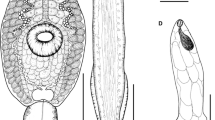Summary
Five echinostome species have been found in man in the Malayan Archipelago, with the following names and spine formulas: Euparyphium Ilocanum. Spine formula Echinoparyphium Recurvatum. Spine formula (3+2)+(8+8)+11+1(8+8)+2+3) Euparyphium Malayan. Spine formula (3+2)+(0+2)+(16+15)+(2+0)+(2+3). Echinostoma Revolutum and E. Lindoensis. Spine formula (3+3)+(0+10)+(6+5)+(10+0)+(3+3). Echinostoma Revolutum and E. Lindoensis. Spine formula (3+2)+(0+6)+(8+7)+(6+0)+(2+3). Echinostoma Lindoensis shows special adaptation to man; all the others are only incidental human parasites with reservoir hosts in rats and birds.
Similar content being viewed by others
References
Beaver, P. C.: Experimental studies on Echinostoma revolutum (Froelich) a fluke from birds and mammals. Illinois Biological Monogr.XV: No. 1, 7–96, 1937.
Garrison, P. E.: A new Intestinal Trematode of Man. Philipp. J. of Science,3:385–392, 1908.
Odhner, T.: Echinostomum ilocanum (Garrison), ein neuer Menschenparasit aus Ostasien. Zool. Anz.,38:65–68, 1911.
Sandground, J. H.: On the occurrence of human echinostomiasis in Java. II. The discovery of an endemic focus of infection with Echinostoma ilocanum and the elucidation of the parasite’s lifecycle. Geneesk. Tijdschr. v. Ned. Indie,79:1722–1734, 1939.
Tubangui, M. A. & Pasco, A. M.: The life history of the human intestinal fluke, Euparyphium ilocanum (Garrison, 1908). Philipp. Journ. of Science,51:581–603, 1933.
Bonne, Prof. C., Borstlap, A. J. P., Lie Kian Joe, Molenkamp, W. J. J., de Moor, C. E., Nanning, W.: Voortgezet onderzoek over echinostomiasis in Celebes. Geneesk. Tijdschr. v. Ned. Indie.,82:3–20, 1942.
Tubangui, M. A.: Worm Parasites of the brown rat (Mus Norvegicus) in the Philippine Islands, with special reference to those forms that may be transmitted to human beings. Philipp. Journ. of Science,46:537–589, 1931.
Tubangui, M. A.: Trematode Parasites of Philippine Vertebrates, V. Flukes from birds. Philipp. Journ. of Science,47:369–402, 1932.
Leiper, R. T.: A new Eehinostome Parasite in Man. Journ. Lond. School of Trop. Med.,1:27–28, 1911.
Odhner, T.: Een zweites Echinostomum aus dem Menschen in Ostasien. (Ech. malayanum Leiper). Zool. Anz.41: 577–582, 1913.
Lane, Clayton: Artyfechinostomum Sufartyfex. A new parasitic Echinostome of Man. Ind. Journ. Med. Res.2: 977–983, 1915.
Sandground, J. H. & Bonne, C.: Echinostoma lindoensis n. sp.; a new parasite of man in the Celebes with an account of its life history and epidemiology. Am. Journ. Trop. Med.20:511–532, 1940.
Bonne, C.: Echinostomiasis aan het Lindoemeer in Centraal-Celebes. Geneeskundig Tijdschr. v. Ned. Indie.,81: 1139–1167, 1941.
Bonne, C., Bras, G., & Lie Kian Joe: Echinostoma revolutum (Froelich 1802) Een nieuwe echinostoom van den mensch op Java. Medisch Maandblad,2: 207–209, 1947.
Author information
Authors and Affiliations
Rights and permissions
About this article
Cite this article
Bonne, C., Bras, G. & Joe, L.K. Five echinostomes found in man in the malayan Archipelago. Amer. Jour. Dig. Dis. 20, 12–16 (1953). https://doi.org/10.1007/BF02881235
Received:
Issue Date:
DOI: https://doi.org/10.1007/BF02881235




